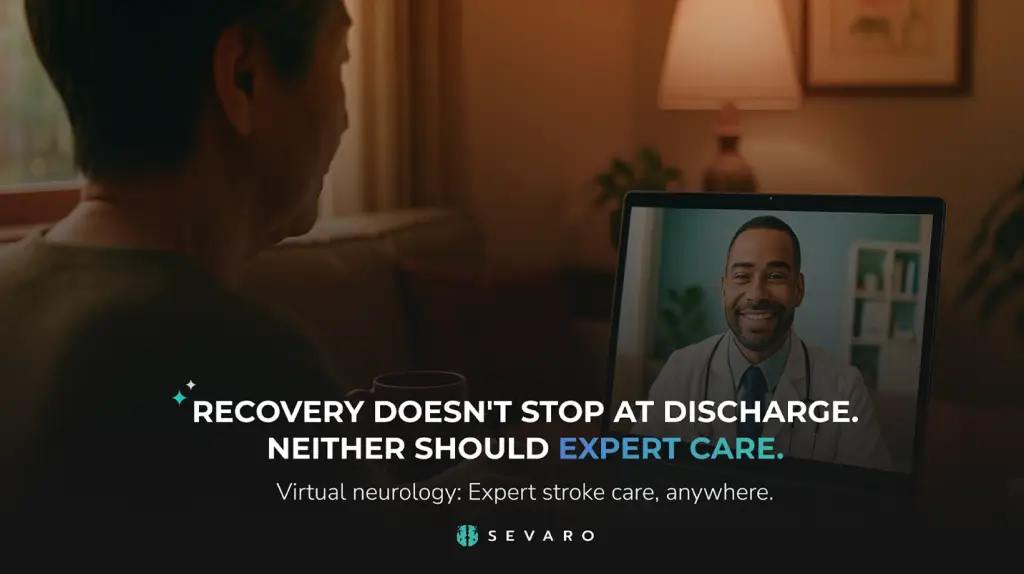Virtual neurology services (including Telestroke & Acute Neurology) ensures that stroke patients receive expert neurological follow-up care without the delays and limitations of in-person visits. By leveraging telehealth platforms, hospitals and health systems can provide ongoing care, rehabilitation guidance, and secondary prevention strategies—all from the patient’s home or local clinic.

A stroke is more than a one-time medical emergency, it’s the start of a lifelong journey of recovery and prevention. While door-to-needle times and ER interventions get most of the attention, post-stroke follow-up is equally critical.
Without ongoing neurology support, patients face:
Higher risk of secondary strokes (1 in 4 strokes are recurrent).
Medication non-adherence and mismanagement of risk factors.
Gaps in rehab and therapy coordination.
Virtual neurology bridges these gaps by providing continuous care and monitoring, ensuring patients don’t just survive but recover and thrive.
Hospitals across the country are expanding their teleneurology programs beyond the ER and inpatient units. Here’s how:
1. Timely Follow-Ups Without the Wait
Virtual neurology allows stroke patients to have follow-up appointments within days, not weeks, of discharge. Whether reviewing imaging, adjusting medications, or addressing new symptoms, these timely touchpoints can prevent complications and rehospitalizations.
2. Bringing Care to Underserved Areas
Patients in rural or resource-limited areas often lack access to neurologists altogether. Virtual neurology bridges that gap, connecting patients with specialists who understand the nuances of stroke recovery and long-term management, regardless of location.
3. Real-Time Monitoring and Adjustments
Virtual platforms enable hospitals to track symptoms, flag deterioration, and offer ongoing care through tools like Synapse AI. This keeps the care team informed and proactive, reducing risk of another event.
4. Supporting the Full Care Team
Stroke recovery involves a village, primary care, physical therapy, occupational therapy, and sometimes speech therapy. Virtual neurologists work as part of that team, coordinating with other providers and supporting patients through multidisciplinary care.
5. Patient Education & Empowerment
Patients and families often leave the hospital overwhelmed. Virtual neurology sessions provide:
Education on BEFAST stroke warning signs.
Lifestyle coaching for secondary prevention (diet, exercise, blood pressure management).
Guidance on emotional and cognitive recovery.
Why Virtual Follow-Up Isn’t Just “Convenient,” It’s Essential
Virtual neurology eliminates these barriers by bringing the neurologist to the patient—wherever they are.
Post-Discharge Scheduling
Patients are scheduled for a virtual neurology follow-up quickly after leaving the hospital.
Secure Video Consultations
Sessions are conducted through HIPAA-compliant telehealth platforms, ensuring privacy and security.
Integrated Care Plans
Sevaro neurologists coordinate directly with the hospital team, primary care physicians, and rehab specialists.
Ongoing Support
Patients receive routine check-ins, medication adjustments, and rapid response consults when symptoms arise.
Hospitals partnering with Sevaro for virtual neurology have reported:
30% fewer readmissions due to proactive follow-up care.
Faster rehab enrollment, resulting in improved functional outcomes.
Higher patient satisfaction, with 9/10 patients preferring telehealth for routine visits.
Preventing a second stroke is a key goal of follow-up care. Virtual neurology visits help by:
Ensuring medication adherence (anticoagulants, antiplatelets, etc.).
Monitoring blood pressure, cholesterol, and blood sugar.
Educating patients on lifestyle factors that reduce stroke risk.
Sevaro’s Synapse AI platform powers its virtual neurology model by:
Prioritizing high-risk patients for immediate follow-up.
Analyzing trends in recovery to adjust care plans dynamically.
Supporting hybrid care models where hospitals use their own neurologists alongside Sevaro’s team, either as back ups during high-volume times or when coverage gaps arise.
Ideally, stroke patients should have a follow-up visit within one week of discharge. Virtual neurology makes this possible, even in remote locations.
Yes. Studies show tele-neurology offers equal or better outcomes for follow-up care, especially when combined with real-time rehab coordination.
Patients only need a smartphone, tablet, or computer with internet access. Sevaro provides tech support to ensure smooth sessions.
Absolutely. Sevaro neurologists coordinate with rehab teams and guide patients through post-stroke recovery milestones.
Yes. Most telehealth services, including virtual neurology, are covered by Medicare, Medicaid, and major insurers.
Stroke recovery doesn’t end in the ER. Virtual neurology provides continuous, expert care that prevents complications, reduces readmissions, and improves long-term outcomes. Sevaro’s Synapse AI-powered platform ensures patients get the fastest and most reliable follow-up care available.
See how Sevaro can transform post-stroke care for your hospital.